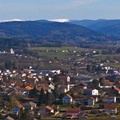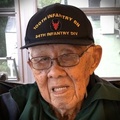A visit in 1960 by then Army Master Sgt. Wilbert “Sandy” Holck (442nd’s Cannon Company), as an international gesture of goodwill, established a sister-city relationship between Bruyères and Honolulu, 7,500 miles away.
A 442nd RCT granite monument and a sculpture “The Ties of Friendship” by Shinkichi Tajiri (3rd Battalion, Company M) was erected in a small forest clearing near Biffontaine. Scores of veterans and their families have made pilgrimages to the Vosges area visiting not only Bruyères and Biffontaine, but also Epinal American Military Cemetery where 11 members of the 442nd RCT are buried. Each homecoming features parades and banquets honoring the returning veterans.
The residents in the retirement home, L’Accueil de la Vologne, in the village of Granges-Aumontzey, continue to honor the Japanese American soldiers for liberating villages in their area, according to Marion Kieffer Rys, who administers cultural activities for the retirement home. The town of Granges-Aumontzey is situated about six miles from Bruyères and nearly seven miles from Biffontaine. “Our retirement home is a humble yet active place of culture,” she added. Bruyères, Biffontaine, Granges, La Houssière and La Chapelle-devant-Bruyères are among the 57 villages that make up the Vosges department or province.
“The project was important for all of us,” Kieffer Rys told The Hawai‘i Herald. “We absolutely needed to learn and transmit to the younger generation as it is something that isn’t well communicated or known. We continue to correspond with people in Hawai‘i.”
Jacqueline Gérard, 97, had taken refuge in a cellar in Bruyères during the German occupation.
“We were in a very good, cemented cellar, we had taken down mattresses, there was a corner with water from the tubs to do the laundry. There was a time when we didn’t go back up to the house, we lived there completely. It was a time when there was constant bombing and the planes passed very low. I can still hear them, I was terrified. We lived in this house, which belonged to rich people who lived in Algeria in [the] winter. My parents were the guardians. We shared the basement with two other families: a young couple whose wife was pregnant and another family with two little girls.”
When she was informed of the project to honor the Japanese American soldiers, Gerard recalled her emotions when she met the veterans for the first time on July 13, 2019. “It was a revelation for me. I had before me those who at the risk of their lives saved mine. I gave all my heart to the creation of the song, to the meeting with the students to tell this story. And today, when I see the many testimonies of thanks for our song, I feel a little proud. But honestly, it is a fair return of things that at the top of my 97 years I can transmit to the young generations our history to never forget.”
During the past 21 years, working at the French retirement home, Kieffer Rys said she has tried to undertake projects, like perpetuating the legacy of the Japanese American soldiers, to take advantage of the residents’ knowledge and expertise, to preserve them and ensure that they are passed on to the younger generations. “Old age is the unavoidable future of man and death.”
To be effective in promoting meaningful activities for the residents she undertook projects where the residents could pass on their knowledge. She views her job as giving value to elderly citizens who are often thought to have nothing to give. “It is necessary to be persuaded that the end of life is just as important as its beginnings.”
She credits Lucette Lievaux and her late husband Camille Lievaux; and Jacqueline Demengeon and her late husband Andre, all who had visited Hawai‘i in 1976, as prime movers in perpetuating the exploits of the Japanese American soldiers in liberating the towns in the Vosges area.
Work on video began in August 2022. The song “Aloha” was created by Jack Simard and arranged by Yannic Villenave. The video also included participation by residents of the retirement home and fourth and fifth grade elementary school students from the neighboring towns of Biffontaine and La Chapelle-devant-Bruyères.

In the first part of the song Lucette Lievaux explains what the word “aloha” means and speaks about the Japanese American soldiers and how we should never forget them, Kieffer Rys said. “She did this spontaneously, without writing. The words came naturally because her encounter with the Japanese American soldiers and visiting Hawai‘i have been important to her.”
She and Jacqueline Gérard met Lawson Sakai (2nd Battalion, Company E) in July 2019 when he visited Bruyères with a delegation of Sons and Daughters of the 442nd Regimental Combat Team from Hawai‘i and the mainland. Sakai died a year later in Gilroy, California, following his 10th and last pilgrimage to Bruyères.
Vintage black-and-white images of Nisei soldiers in the Vosges region and in the aftermath of the 1944 battles are intermixed in the French video along with photographs of various monuments erected in the area.
Lynn Heirakuji, board director of the Nisei Veterans Legacy, found the video “to be very touching. “
“The French have held true to their promise that they will never forget what the Nisei soldiers did to help them during WWII. They annually commemorate the 100th/442nd’s renowned 1944 Rescue of the Lost Battalion in the Vosges Mountains, which resulted in tremendous casualties as representing their final liberation from German occupation. This video is a demonstration of their commitment to never forget – even now some 80 years hence,” added Heirakuji, whose organization’s mission is a commitment to ensure that future generations learn the legacy of Hawai‘i’s Nisei soldiers.
“The video is particularly moving because it is a beautifully crafted original creation and performed by a multigenerational ensemble of elders, young adults, and children. What better way to perpetuate the legacy of service of the Nisei soldiers and the immutable friendship between our countries than through music and the youth of France.”
It also was an emotional moment for Guillaume Maman, honorary consul of France in Honolulu, when he first saw the video last year. “I had tears in my eyes,” he said.
Maman, who joined Case and Mayor Kirk Caldwell in the October 2019 delegation, said the video was exceptionally moving because four generations of French people participated in the project and performed together. “It is their way of giving back their understanding of the meaning of ‘Aloha’ by continuing to show their gratitude towards the people of Hawai‘i and the Nisei veterans of the 100th/442nd who liberated them in October 1944,” Maman told The Hawai‘i Herald.
“It’s a way for them to honor and perpetuate the legacy of their heroes. The people of Bruyères, Biffontaine and the other neighboring villages continue to celebrate each year October 18 and 19, the days of their liberation by the U.S. 100th/442nd from the Nazi occupation. As the song states ‘L’histoire est gravée dans la terre’ (History is engraved in our ground), so this song is a way to show their eternal gratitude for their freedom and preserve a special part of their history.”
Steve Migdol, webmaster for the Sons and Daughters of the 442nd Regimental Combat Team, shared the Aloha video with 100th Battalion veteran Jack Nakamura, who pointed out people he knew and scenes he recognized from his visits to the French battlegrounds after the war. Nakamura remarked after seeing the video: “That was nice. I’m just happy to meet them. I would like to see them again.”
When asked what he would like to tell the residents Nakamura said back then he was asked to sing the national anthem and while Migdol was videotaping he began singing the “Star-Spangled Banner” and ended singing in French the World War II love song “Seule Ce Soir” to the people who recorded the Aloha video. The title of the song is “Alone Tonight,” said Migdol. “Apparently it was popular in France during the war, which is when Jack heard it and came to love it.”
Nakamura is one of 12 known remaining survivors of 100th Infantry Battalion which was formed with 1,432 men right after Pearl Harbor and went into battle under the motto “Remember Pearl Harbor” before the arrival of the 442nd RCT in Europe. Nakamura celebrated his 100th birthday in February.
Migdol sent Nakamura’s video to Kieffer Rys who shared it with the retirement home residents. “One of them, Mademoiselle Gerard, made a video back to him where she thanks him for saving her and sings part of the chorus of “Seule Ce Soir” back.
Since 2001, the French government has awarded its highest civilian award, the Legion of Honor, to servicemen who participated in the liberation of France and were still living when the award was requested. One hundred seventy-three 100th/442nd veterans have received the medal and the rank of Chevalier.
Juanita Allen, secretary for the Sons and Daughters of the 442nd Regimental Combat Team, said both the Nakamura and Bruyères videos are posted on the organization’s website, 442sd.org, along with the Army unit’s roster. “There are many bios of men who died in the Vosges,” she added.
At the end of the Vosges campaign in early November, Duus notes that the ranks of the 100th/442nd, which had started with 2,943 soldiers – had been cut by one third. The 100th/442nd suffered nearly 350 casualties, including 54 killed in action and almost 300 injured to rescue 211 Texas soldiers. The 442nd RCT’s daring rescue of the “Lost Battalion,” belonging to Texas’ 141st Infantry Regiment and liberation of Bruyères are honored as one of the 10 most significant battles in U.S. military history, distinguishing the 442nd RCT as one of the most decorated Army units for its size and length of service. The Texas soldiers had been stranded nine miles into German territory near the hamlet of La Houssiere for five days and were running low on food and ammunition.
In June 1944, the 100th Infantry Battalion was attached to the 442nd RCT and became the regiment’s first battalion. The motto of the 100th Infantry Battalion was “Remember Pearl Harbor” because many of its soldiers were already in the Army when the Japanese attacked Pearl Harbor in 1941 and whose achievements in training paved the way for the creation of the 442nd RCT.
The soldiers of the 100th/442nd participated in eight major campaigns in France, Italy, and Germany, earning seven presidential unit citations, the highest award the Army can bestow on a single unit. The Nisei soldiers earned one Medal of Honor (20 were added in June 2000), 49 Distinguished Service Crosses (19 were later upgraded to the Medal of Honor), one Distinguished Service Medal, over 4,000 Purple Hearts, 560 Silver Stars and 28 Oak Leaf Clusters in lieu of a second Silver Star (one was upgraded to the Medal of Honor), 22 Legion of Merits, 4,000 Bronze Stars with 1,200 Oak Leaf Clusters in lieu of a second Bronze Star, 15 Soldier’s Medals and 12 French Croix de Guerre with Palms representing second awards, two Italian Crosses for Military Merit and two Italian Medals for Military Valor.
The 442nd RCT was demobilized in August 1946 but was reactivated as an Army Reserve unit a year later.
Watch the French “Aloha” video with English subtitles
*This article was originally published in The Hawa‘i Herald on March 3, 2023.
© 2023 Gregg K. Kakesako / The Hawaii Herald







